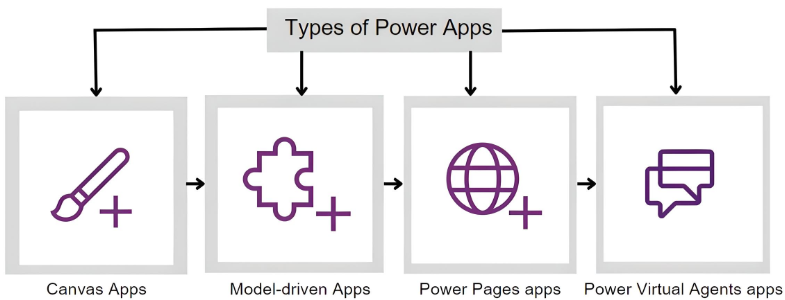For companies looking to grow and succeed in the ever-changing digital transformation landscape, having the capacity to use efficient resources is essential. Power Apps has become a game-changer with its approachable platform empowering IT pros and beginner developers.
Companies can strategically utilize Power Apps to advance digital transformation strategy to encourage creativity and attain operational excellence, as this blog provides insightful guidance on its core.
Power Apps and Their Types
Power Apps is an easy-to-use platform for developing low-code applications that enables anyone to design unique apps for various business requirements without complex coding knowledge.

PowerApps can create apps with every app having a distinct function related to business processes.
- Canvas Apps
For designing unique user interfaces and experiences, canvas apps are perfect. Users using canvas apps can drag and drop various components, including videos, forms, charts, and data tables. It enables companies to develop apps specific to their requirements and working methods.
- Model-driven apps
Businesses that handle intricate data models and processes are the ideal candidates for model-driven apps. It makes companies develop effective and scalable apps integrated with their data and operations.
Pre-built elements and templates like forms, views, and dashboards come under model-driven applications.
- Power Pages apps
Combining the flexibility of canvas apps with the data management features of model-driven apps, Power Pages are a cross between the two types of applications. These are canvas apps with extra functionality for data management and integration.
For companies that need to create highly visual, data-driven applications, Power Pages are suitable for building personalized dashboards, intranet sites, and portals that give users a consolidated view of their workflows.
- Power Virtual Agents apps
Users may automate customer interactions and service requests by creating chatbots and virtual agents with Power Virtual Agents.
Use Power Virtual Agents to incorporate natural language processing for more advanced chatbot interactions.
Ways to leverage power apps for digital transformation
- Rapid prototyping
Rapid prototyping highlights the agile nature of development. With Power Apps, organizations can quickly develop functioning models of apps through rapid prototyping, facilitating concept validation and visualization. Quick feedback collecting is made possible by this iterative method, which guarantees that stakeholders and end users can actively contribute to improving the functionality and design of the application.
Organizations may expedite the development cycle and provide solutions that closely fit the dynamic requirements of the digital transformation journey by quickly prototyping with Power Apps. This methodology guarantees that the end applications satisfy the requirements of the changing digital environment.
- Low Code governance
To ensure that low-code development within an organization complies with security standards, compliance requirements, and business objectives, rules, processes, and controls must be established.
Low-code platforms such as Power Apps enable citizen developers to create programs with visual interfaces. Governance frameworks guarantee that these developers know about security precautions, best practices, and compliance requirements by offering them training and instructions.
Organizations may exploit the power of Power Apps for digital transformation while reducing risks, guaranteeing compliance, and promoting a culture of responsible and efficient low-code development by implementing strong low-code governance policies. This strategy preserves control with broad corporate plans, allowing agility and innovation.
- Automate manual processes
With Power Apps, businesses may develop unique apps that automate and optimize labor-intensive manual processes. It eliminates the need for repetitive jobs, approval procedures, and manual data entry, which results in significant time savings.
Businesses can leverage Power Apps to integrate AI and machine learning capabilities for intelligent automation and decision-making.
Power Apps-enabled automation quickens workflows, guaranteeing task completion and freeing teams to concentrate on higher-value work.
Non-technicals or citizen developers can automate their operations with the help of Power Apps. Business users can design customized apps to meet their requirements, which lessens the need for IT professionals to handle every automation demand.
By creating apps that automate tasks, business users may take control of their processes and adapt more quickly to changing business requirements.
Using the PowerApps application to automate manual activities is a crucial digital transformation approach. Organizations may improve efficiency, empower users, foster collaboration, and quickly adjust to changing business environments by utilizing this low-code platform. As a result, companies can be more customer-focused, cost-efficient, and agile to succeed in the digital age.
- Data integration
Businesses can combine data from several sources, such as databases, cloud services, and external APIs, using Power Apps.
Users can access unified dashboards and interfaces that offer a comprehensive picture of pertinent information by combining data through Power Apps.
Microsoft’s business intelligence tool, Power BI, can be smoothly integrated with Power Apps. Making dynamic dashboards and reports is made possible by this integration, which improves data-driven decision-making.
Visual exploration and analysis of integrated data allow users to find trends, patterns, and practical insights.
Through the unification of data sources, provision of real-time access, and promotion of operational efficiency, Power Apps serve as an organizational catalyst for collaboration and agility.
- Version control
Version control offers experimentation with the security net. As earlier iterations are maintained, developers can confidently make changes and lower the possibility of unexpected repercussions.
Version management minimizes downtime and potential disruptions by enabling a swift and smooth rollback to a stable release if a new version presents a problem.
Version control makes it easier for team members to collaborate while developing Power Apps, enabling them to work on them simultaneously. On assigning particular features or fixes to each version, teams can better organize releases. It helps to align releases with deadlines and corporate objectives.
Conclusion
Utilizing Power Apps for digital transformation is an intriguing and liberating experience. It asks for a vision of a future in which technology is a facilitator rather than a constraint, a commitment to continuous development, and a strategic alignment of technology with corporate goals. Organizations may successfully negotiate their digital ecosystem by embracing innovation and turning obstacles into opportunities for growth and success when they use Power Apps as a core.
